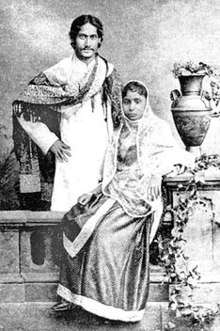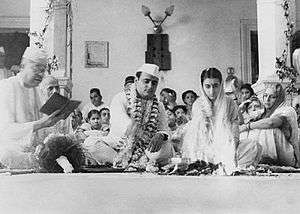Adi Dharm
Adi Dharm refers to the religion of Adi Brahmo Samaj (Bengali: আদি ব্রাহ্ম সমাজ, Adi Brahmô Shômaj) the first development of Brahmoism and includes those Sadharan Brahmo Samajists who were reintegrated into Brahmoism after the second schism of 1878 at the instance of Hemendranath Tagore.[1]
Tenets
It was never conceived as an "anti-caste" movement, but stood for repudiation of all "distinctions between people" and foundation of a modern educated secular Indian nation under the timeless and formless One God, and its adherents as Adi-Dharmis (or worshipers of the ancient formless indivisible One god Brahma or the Parambrahma "The One without a Second" or EkAdavaitam). Although the doctrine of Adi Dharma is superficially similar to other reformatory "sects" of Hinduism which speak of "different paths to One God", the core beliefs of Adi Dharm irrevocably place Adi Dharm and Brahmoism as the youngest of India's nine religions beyond the pale of "Hinduism's catholicism and elasticity".[2]
The core Adi-Dharma doctrinal beliefs differing from Brahmanical Hinduism include:
- There is only One "Supreme Spirit", Author and Preserver of Existence. (... Beyond description, immanent, transcendent, eternal, formless, infinite, powerful, radiant, loving, light in the darkness, ruling principle of existence .... Polytheism is denounced. Idolatry i.e. worship of images is opposed.)
- There is no salvation and no way to achieve it. ("Works will win". Worshipful work is the way of existence. Work is for both body and soul. All life exists to be consumed. The soul is immortal and does not return to this World. There is neither Heaven nor Hell nor rebirth)
- There is no scripture, revelation, creation, prophet, priest or teacher to be revered. (Only the Supreme Spirit of Existence can be revered – not the Vedas, Granths, Bibles or Quran etc. Worship consist of revering the "inner light within" i.e. enlightened conscience)
- There is no distinction. (All men are equal. Distinctions like caste, race, creed, colour, gender, nationality etc. are artificial. There is no need for priests, places of worship, long sermons[3] etc. "Man-worship" or "God-men" are abhorrent to the faith and denounced since there is no mediator between man and God).
Genesis of Adi Dharma

The Adi Dharma founders were regularly tainted and scandalised by orthodoxy as Pirali Brahmin and defamed as being officially banned from entering temples like Jaganath Temple (Puri) by Govt regulations of 1807.[4] Subsequently, their families also faced great difficulty in arranging marriages for some of their children such as India's poet-laureate Rabindranath Tagore who could only manage a Pirali Brahmin bride unlike his brothers who married high caste Brahmin brides. This ultimate exclusionary weapon of Hindu orthodoxy resulted in endogamous (i.e. casteist) tendencies in Adi-Dharm marriage practice between these 2 branches of Adi Dharma in the Tagore family, placing Satyendranath Tagore and Rabindranath Tagore and their families against their exogamous brothers. The noted Adi Brahmo historian Kshitindranath Tagore (son of Hemendranath Tagore) who succeeded Rabindranath Tagore as Editor of the Adi Dharma organ, has written that it was Rabindranath who destroyed many family documents.[5]
Adi Brahma Dharm timeline
Adi Brahma Sabha
Consequently, the Adi Brahmos then set up their own faith called Adi Brahma Sabha in 1828/1830 by Trust deed of Brahmo Sabha and codified their religion as Adi Brahma Dharma published from 1848. The founders of this Brahmo religion were foremost reformers for nationalism, equality, secularism and education which now stand enshrined in the Constitution of India as Fundamental Rights. These founding fathers of Adi Dharma believed then that Hinduism was thoroughly corrupted and debased and that strong Law (i.e. Dharma) of first Moslems and then English Rulers could cleanse India from these evils. For their associations with the Rulers of the times, they were ostracised and barred from orthodox Hindu society but were amply compensated by "being so weighed down in honours by the British that they forgot all the radicalism of their youth." It was Dwarkanath Tagore alone who could publicly lambast an English Magistrate Abercrombie Dick on the emergence of servile mai-baap (great lord) ruling culture of 19th-century Bengal as follows:
... If Mr.Dick wishes me to specify what I deem the present characteristic failings of the natives I answer that they are – a want of truth, a want of integrity, a want of independence. .. arising from being subjected to misrule of an igorant, intolerant and licentious soldiery .. falling into abject submission, deceit and fraud.[6]
Caste Disability Removal Act (1850)
This publication resulted in the famous "Removal of Caste Disabilities Act" of August 1850, and Brahmos were free to establish their own religion and marry amongst themselves without fear of disinheritance from ancestral property. At the 23 December 1850 annual meeting of Calcutta Brahmo Samaj, Debendranath formally announced the Brahma Dharma as doctrine of the new religion. This announcement resolving certain aspects of Hinduism in Rammohun's doctrine also served to effectively separate Brahmoism from Hinduism.[7]
Lala Hazarilal's Shudra controversy (1851)
Krishnanagar in Nadia district of West Bengal has always had special place in Brahmoism. Many old Brahmo families came from here including that of Ramtanu Lahiri who was the first Adi Dharmi to renounce his Brahmanical caste thread in 1851 (even before Debendra Nath who removed his in 1862). The gesture by Debendranath of sending Lala Hazarilal of Indore (an untouchable from the lowest Shudra caste by birth) as Adi Dharma's first preacher to Krishnagar instead of a Brahmin preacher well versed in Sankskrit literature was, however, not too well appreciated and gave great offence to the Nadia royal family.[8]
Lala Hardayal pracharok in Northern India (1876)
- "He contributed to the political sphere by his activist journalism of writing about issues such as corruption in the local administration. The presidency government kept a close tab on the Indian language press and sometimes responded to investigate such allegations. Viresalingam also intervened more directly by conducting widow remarriages and popularising new forms of voluntary association."[9]
Kandukuri vacillated between Adi Dharm nationalism and Keshab Sen's dictum of "Loyalty to Sovereign" being rewarded with Rao Bahadur title in 1893 by British. But by clinging to Keshab Sen philosophy of "Loyalty to Sovereign" till 1907, Viresalingam found himself increasingly isolated from the militant ideology of Adi Dharma's new stridently nationalistic adherents in the region.[10]
Marriage validity controversies (1938–)

In 1938 Jawaharal Nehru's daughter Indira insisted on marrying her sweetheart Feroze. Once again being of different faiths they could not be legally married under any law of the time except the Adi Dharma Law. The elders (incl. Rabindranath Tagore) of Brahmo Samaj at Shantiniketan, Delhi and Allahabad were consulted (incl. by M.K.Gandhi) and who after considerable disagreement advised instead that the long pending Marriage Validity law for converted low caste Arya Samajis be enacted, which was speedily done in 1939 by an obliging British Government, enabling the loving couple to be wed in early 1942 by secret pre-Vedic Adi Dharm reformed Brahmic rites taught to Nehru's priest by Adi Dharma elders at Allahabad in the presence of Brahmos like Sarojini Naidu with the groom wearing a sacred Brahmic thread in secret.[11][12] Ever since, these Adi Dharma rites have been used by the Gandhi-Nehru family for their marriages – such as for Rajiv Gandhi to Sonia Gandhi, Sanjay Gandhi to Maneka Gandhi, Priyanka Gandhi to Robert Vadra etc. and the Vedic law of Adi Dharma has never been repealed despite passage of the Hindu Code in 1955 which repealed all such similar marriage validity laws for other faiths.
Legal Status of the Brahmo (Adi Dharma) Religion
In 1916 the Indian Civil Services Ethnography Administration Surveyor R.V. Russell examines in detail and publishes that Brahmo Samaj is indeed a Religion (and differentiates it from "sects").[13]
Future of Adi Dharma
The Adi Dharma movement of the Brahmo religion is today the largest of the Brahmo developments with over eight million adherents. Adi Dharma has spawned not only the Indian National Congress party but also the Hindutva agenda of their opposition. Its radical contribution to India's polity was summed up by a President of India,
- "It is ironic that a small dedicated group of outcaste twice born Brahmins of the highest caste of Bengal setting out to rid India of caste and prejudice have instead engendered a national Constitution which perpetuates a divisively violent Casteism in Hindu religion which tears the social fabric of India apart especially in the field of education."[14]
See also
- Adi Brahmo Samaj
- Arya Samaj
- Bodo Brahma Dharma
- Brahmo
- Brahmo Samaj
- Tattwabodhini Patrika
References
- Particularly those Sadharan Brahmos who accept the core 1830 Adi Dharma Trust Principles
- "31 Cal 11" Indian legal citation Rani Bhagwan Koer and Ors v. J.C.Bose and Ors.
- Dwarkanath Tagore was most astounded in his First Voyage to England by the long lectures delivered as sermons at the Episcopal Kirk in Scotland. Little did he know that back home his son Debendranath was plotting a similar tradition of long sermons for Brahmos. Source: Dwarkanath tagore:A Life – Krisha Kriplani. p191.
- Note By Dr. B. R. Ambedkar To The Indian Franchise Committee, (Lothian Committee) on the Depressed Classes, Submitted on 1 May 1932. "IV. Depressed Classes in Bengal", ".. (10) Rajbansi, (II) Pirali, (12) Chamar, (13) Dom, .."
- Dwarkanath Thakurer Jibani publ. Rabindra Bharati University, Calcutta
- The Englishman – 6 December 1838.
- J. N. Farquhar, Modern Indian Religions, 1915.
- Sivanath Sastri "History of Brahmo Samaj" 1911//1912 2nd edn.pg. 377 publ. "Sadharan Brahmo Samaj, Calcutta 1993"
- "Fashioning Modernity in Telugu: Viresalingam and His Interventionist Strategy" Vakulabharanam Rajagopal University of Hyderabad, Sage Publications (2005) page 66
- Rajagopal (2005) page 69
- Meena Agarwal (2005). Indira Gandhi. New Delhi: Diamond Pocket Books. p. 31. ISBN 978-81-288-0901-9.
The pheras took place at night. The marriage ceremony was performed according to the Vedic tradition.
- Katherine Frank (2002). Indira: The Life of Indira Nehru Gandhi. pp. 177–178. ISBN 978-0-395-73097-3.
The ceremony uniting Indira and Feroze was neither conventional nor legal ... They were both reluctant to sign a declaration that they did not belong to any religion. .. Hence the illegality of ... Indira's marriage.
- "Tribes and Castes of C.Provinces of India, R.V.Russel and Rai Bahadur Hira Lal, Vol 1 of 4 Volumes, Macmillan, London, 1916 "
- From the commemorative speech by N Sanjeeva Reddy, 27 Jan. 1981 at Kanpur for centenary celebrations of the Brahmo Conference Organisation.